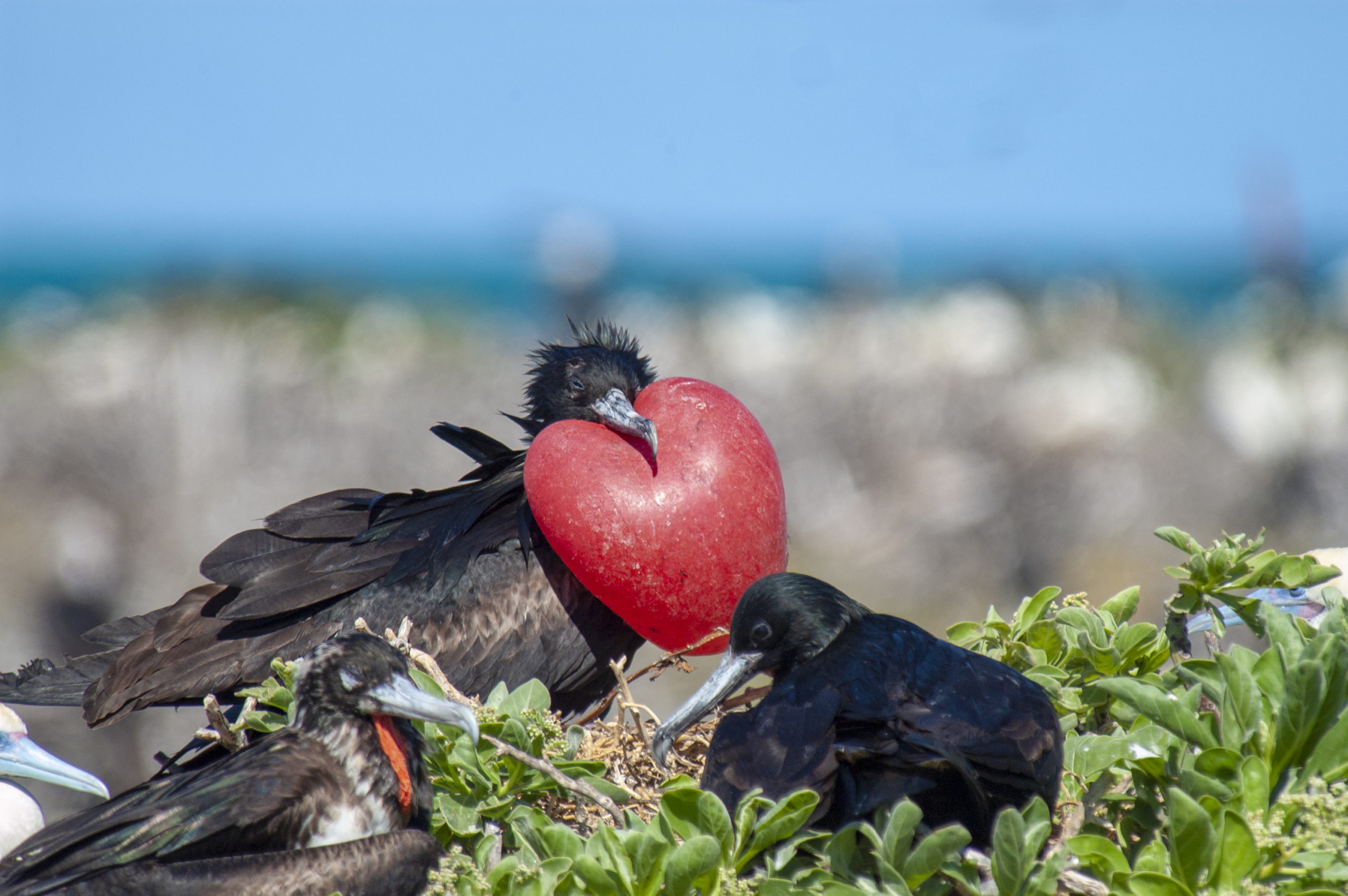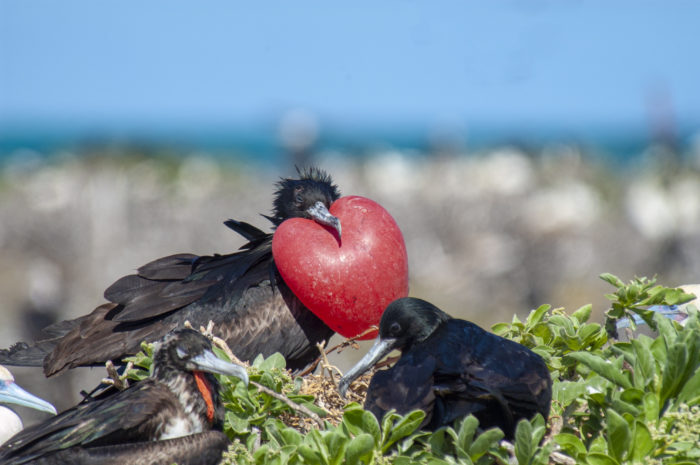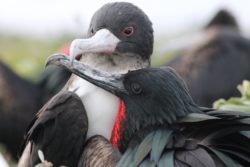
Sea Wonder: Magnificent Frigatebird

Photo Credit: Robert Schwemmer
The magnificent frigatebird (Fregeta magnificens) is a species of seabird found in the southern United States, Mexico, and the Caribbean. They spend most of their lives in flight, which makes sighting one a real treat. But what makes these birds so magnificent?
Appearance
Magnificent frigatebirds are large seabirds with long, angular wings, a hook-tipped bill, and a forked tail. They are the only species of seabird in which males and females look distinctly different, a biological term known as sexual dimorphism.
They can reach nearly four feet in length when full grown, weighing up to five and a half pounds, and a maximum wingspan around seven feet. To put this into perspective, they are the size of or larger than geese. Females are often larger than males.
Males and females both have black feathers all over their bodies except for the front, where males have bright red pouches under their throat, which they can expand for mating rituals, while females and juveniles have patches of white feathers along their chests, heads, and bellies; juveniles start their lives with a tan streak on the upper part of their wings.
Diet and Habitat
The magnificent frigatebird generally feeds on small fish but will also feast on squid, jellyfish, crustaceans, newly hatched sea turtles, and even other birds or eggs by snatching these animals from their habitat without landing. They are opportunistic feeders, meaning they will eat almost anything they can find that is edible, and they have a reputation for piracy. Sometimes referred to as the “man-o-war bird”, they will harass and chase other birds until they give up recently captured food, even if they already ate it. Young frigatebirds will learn how to steal food from other birds by observing adults and practice through play behavior — groups of juveniles will carry sticks in their mouths, chasing each other until one member of the group drops their stick, and the others will dive below to catch it.
Unlike other species of seabird, frigatebirds don’t have waterproof feathers, so they rarely land on the water to make sure they can maintain their body temperatures. They spend most of their lives soaring over tropical and subtropical regions of the ocean throughout the Americas. They can be seen all year long in Hawaii and the Florida Keys, from June to August in Flower Garden Banks, and sometimes in Gray’s Reef national marine sanctuaries. They will forage in lagoons and on open water, nesting in short-growing vegetation like shrubs and mangroves and rocky areas on small islands. Very rarely will frigatebirds cross large areas of land, but occasionally they will be seen near large bodies of fresh water when crossing oceans through Florida or Panama.
Life History

Photo Credit: Mark Sullivan
Large colonies of frigatebirds gather on coastal islands for the breeding season, which happens in the cooler months of the year depending on where they live. Nests are often clustered close together and built by females who use materials brought to them by the mates they choose.
To find a mate, males will inflate their throat pouch to look like a large red balloon and complete mating dances which involve raising their bills high into the air, vibrating their wings, swiveling their bodies back and forth, and calling out with their harsh, guttural vocals. Once females have selected one mate for the season, they will lay one egg. Unlike other species of birds, they likely do not mate for life. The oldest observed frigate bird was nearly 20 years old, but their average and maximum lifespans are not known.
Magnificent frigatebirds have one of the longest mating and incubation periods of any seabird, which totals nearly 60 days. Both parents incubate and feed their chicks, never leaving the nest unattended until the newborns are about three months old. Fathers will leave the nest for the year around the same time while the mothers remain to continue feeding their young. Juveniles will leave the nest at around six months of age and accompany their mothers until they are about a year old. Since females lay one egg per breeding cycle and invest so much time into each individual born, scientists believe it is unlikely that they breed every year, but rather every two or three years.
Frigatebirds can be seen traveling independently or in small groups, gathering in large groups only for the breeding season. They generally travel in a localized area and do not migrate very far, with the exceptions of immature juveniles who will occasionally break from the flock and wander. Frigatebirds will generally take flight later in the afternoon for the greatest chance of high winds and favorable thermal conditions, which help keep them in the air. They rely on air currents to keep them aloft, rarely flapping their outstretched wings, but when they do the wingbeats are slow and deep. Since much of their lives are spent in flight, they will sleep by resting one half of their brain at a time for short durations throughout the day so they can remain aware of their surroundings and able to hunt or escape threats if needed.
Threats and Conservation
Scientists have difficulty monitoring frigatebird populations due to their airborne lifestyle, but it is likely that populations have declined as a result of increased coastal development and interactions with fisheries. Climate change and other threats will also be likely to reshape the range and mating seasons of magnificent frigatebirds.
No matter where we live or what our lifestyle, we can make changes in our own behavior to benefit seabirds like the magnificent frigatebird and make sure generations to come have the opportunity to see them flying along the coasts. Some changes include reducing our individual carbon footprints, choosing responsibly sourced and sustainable seafood, and refusing single-use items in favor of reusable alternatives where possible so that these birds don’t nest with and mistakenly feed on our litter.
